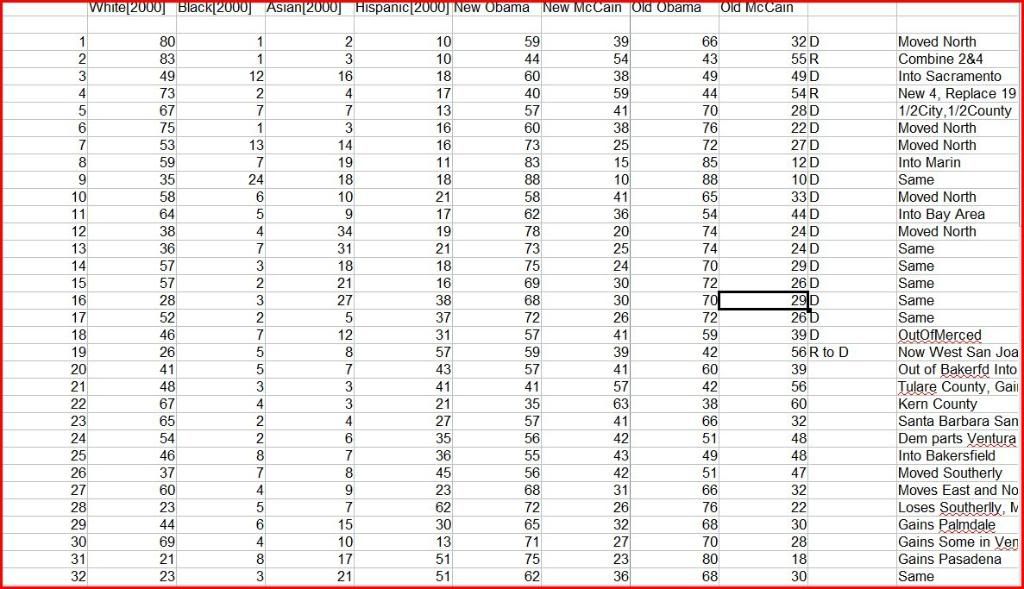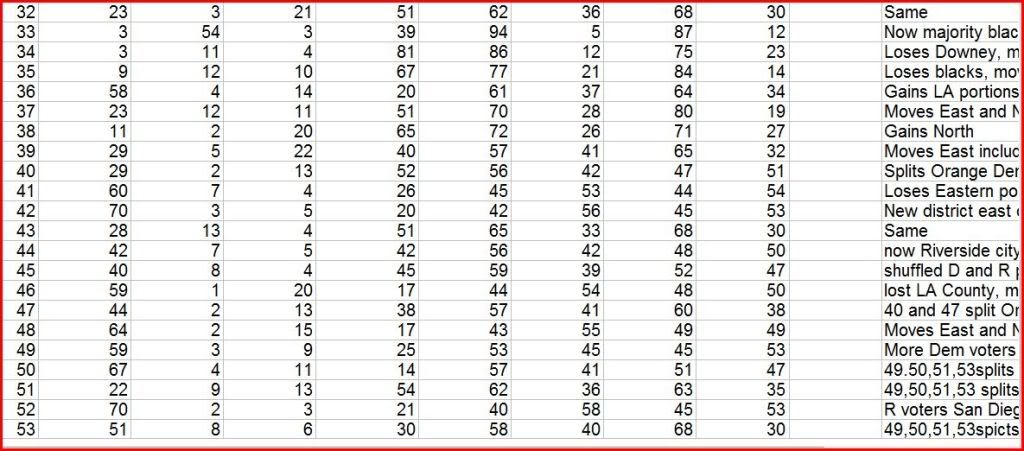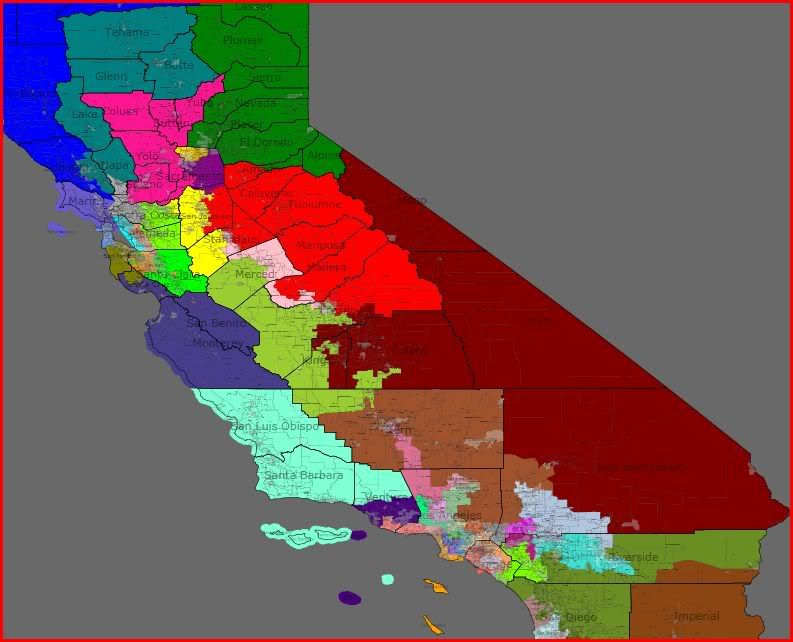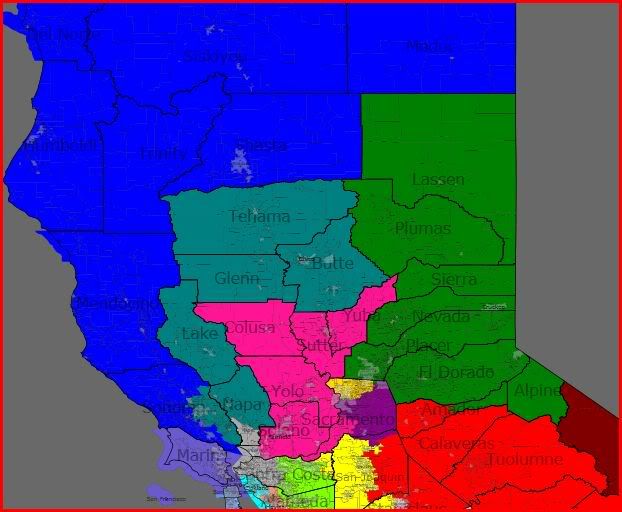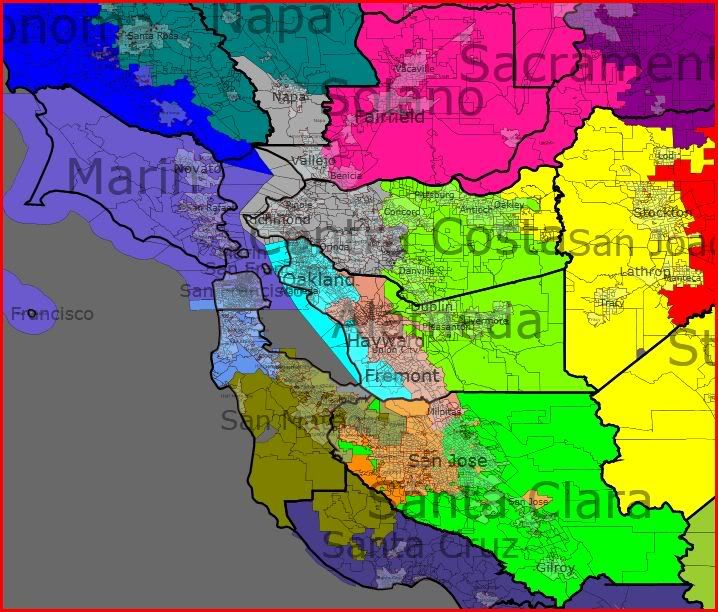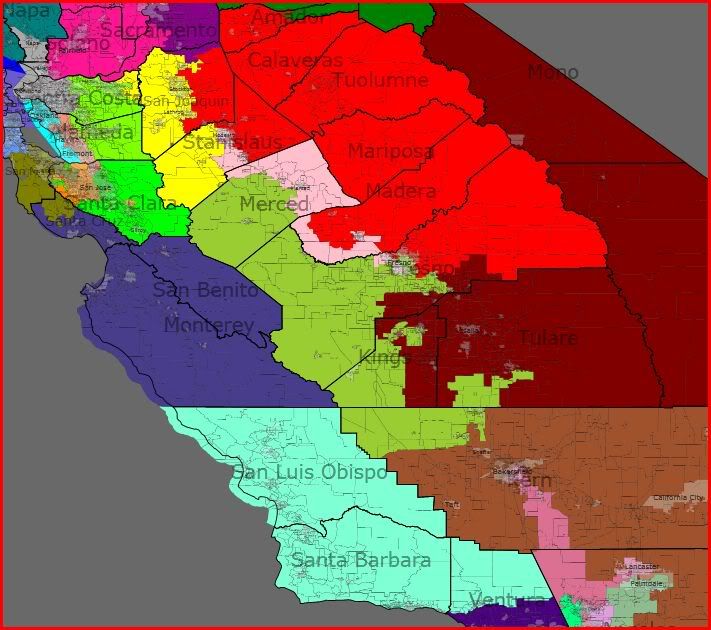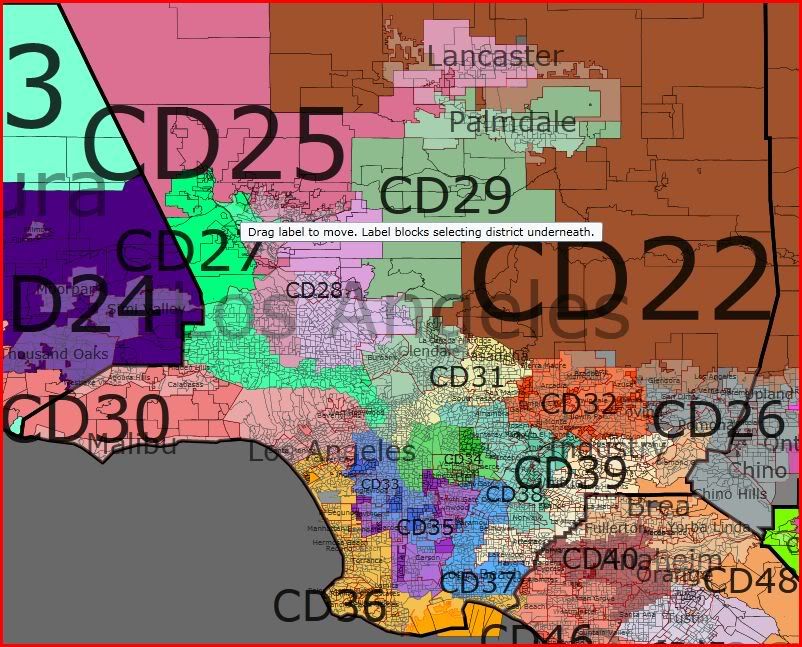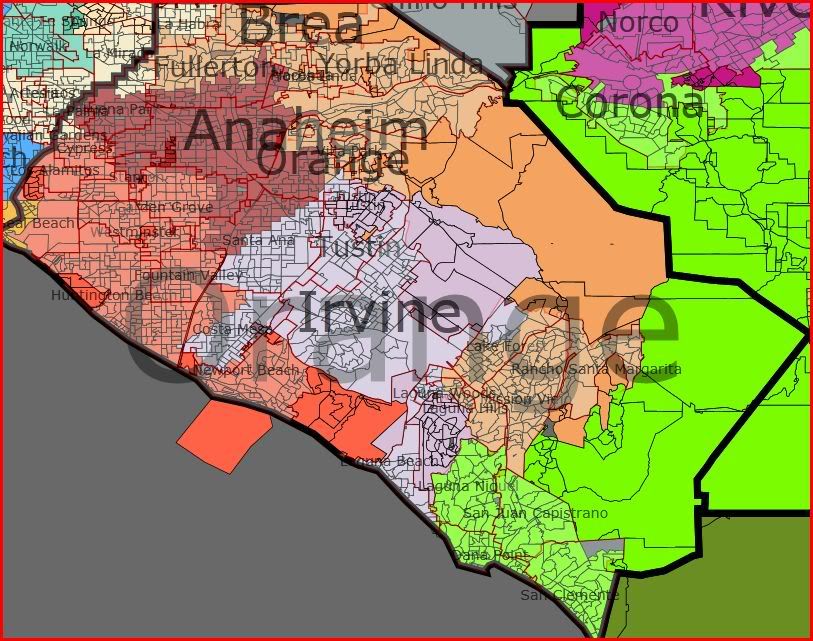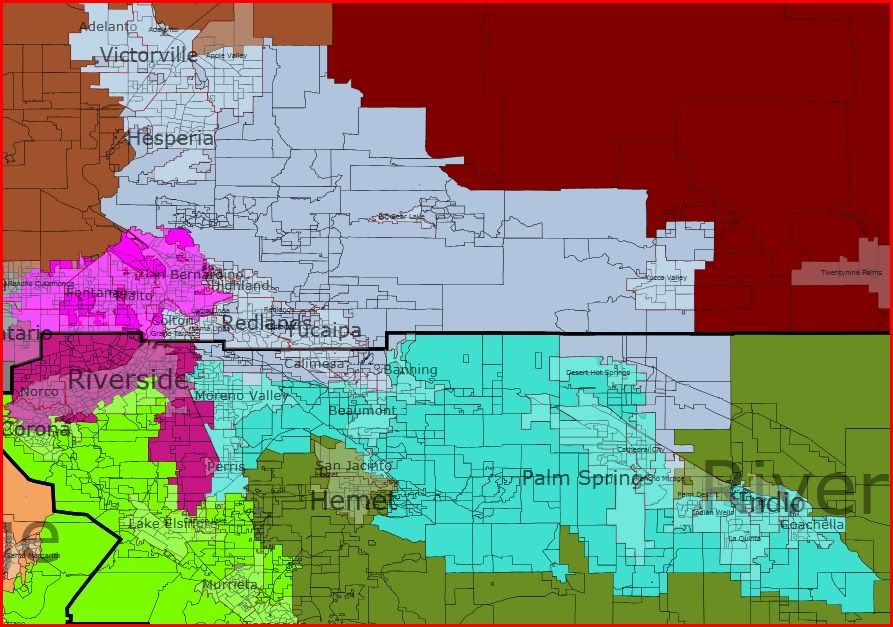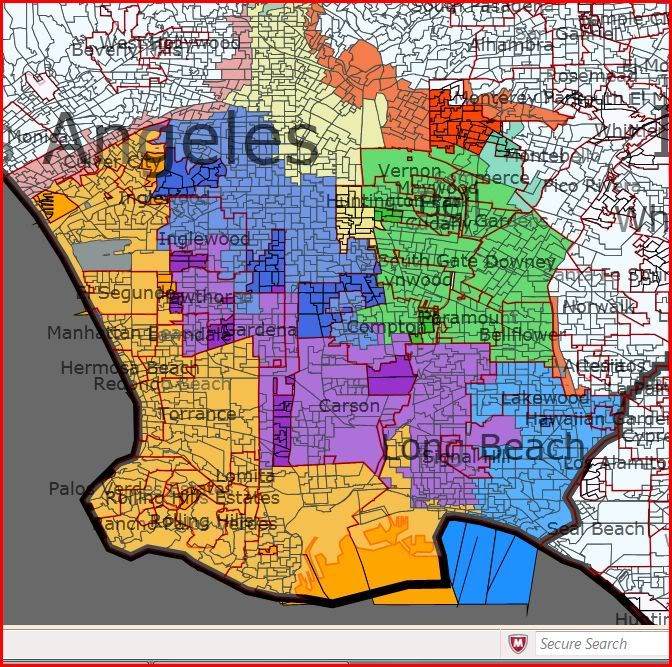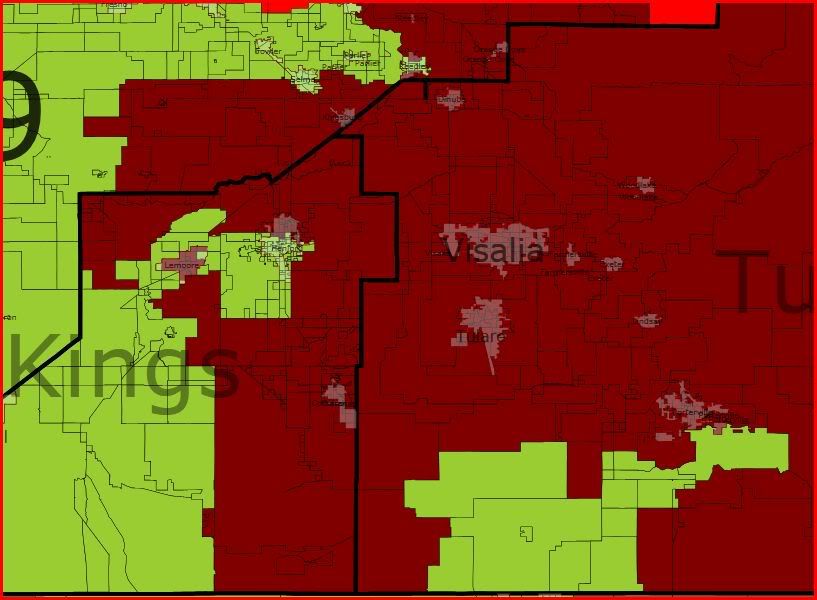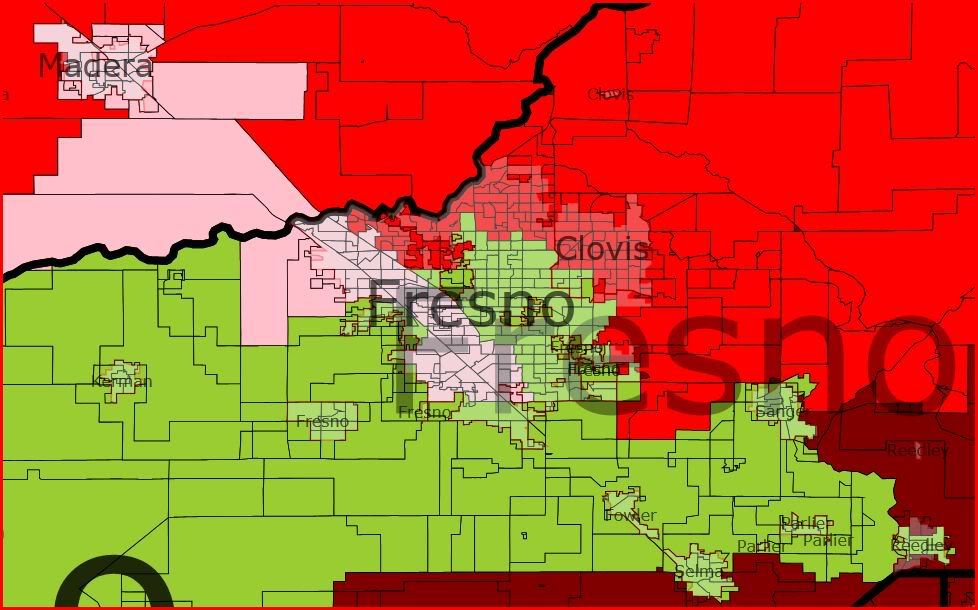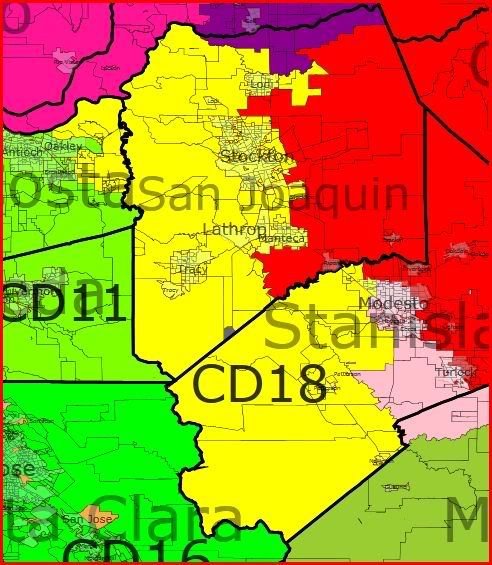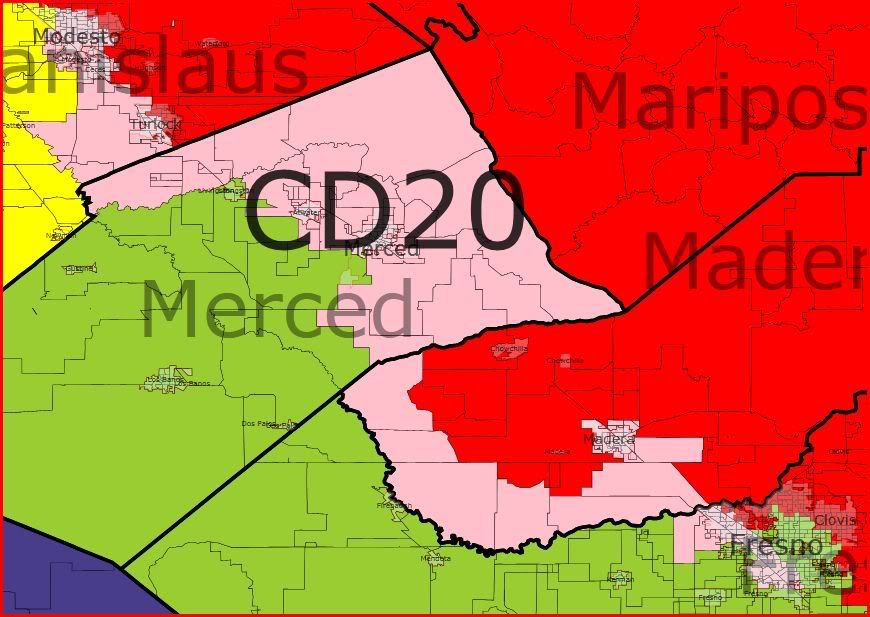(I have cross-posted this diary on Calitics)
This is my first attempt at California since the partisan data by precinct became available in Dave’s Application.
My diaries are often long, and it takes me a while to get to the point. So, I will summarize the bottom line here:
* 43 solidly Democratic districts created; in each McCain gets 37% of vote or less (currently there are 34 Democratic representatives from California, and 1 of the 34 holds a swingy seat)
* Remaining 10 districts to GOP, with possibility that 2 of the 10 go our way at some point in the next decade
* 19 Hispanic majority districts created; 18 of the 19 are at least 55% Hispanic, so that a Hispanic representative has a real chance of being elected (currently, there are only 8 Hispanic representatives from California). An additional 13 seats are minority-majority (with either an Asian or African-American plurality or no particular racial/ethnic minority dominant).
Now, back to the more lengthy explanation …
I wanted to create as many minority-majority or minority-plurality districts as possible. Although in most states an increase in the number of minority-majority districts would have an inverse relationship with an increase in the number of Democratic districts, in California that relationship appears complimentary: an increase in Democratic districts goes hand-in-hand with an increase in Hispanic and other minority-majority or minority-plurality districts.
There’s one issue here that is a bit tricky. The dataset with the Obama/McCain partisan numbers also uses 2000 census demographics. Under the 2000 census, California was 47% white and 32% Hispanic. However, more recent data, from the 2006-2008 American Community Survey indicates that the state was approximately 42% white and 37% Hispanic. The ACS data does not go down to the census block level, and therefore Dave’s Application relied on Census 2000 data, to the block level, to generate racial/ethnic composition data for each precinct for the partisan data model. On the other hand, the original dataset without partisan numbers does appear to use the more recent numbers — down to the county level (I am not sure if the ACS 2006-2008 data was used, but the resulting percentages correspond almost exactly to what the ACS numbers look like — 42% white; 37% Hispanic).
Therefore, for the purpose of this diary, I will list the demographic data for each district using the exact (yet older) demographic data, but will also provide estimated numbers using the newer (though more geographically inexact) data. I was able to do this by “redrawing” my map from the partisan model into the original matrix without the partisan data. So, please keep in mind that the 2006-2008 demographic numbers are just estimates, though they are closer to the current demographic situation than the 2000 data.
To make sure that a Hispanic-majority district has enough of a minority population to provide an opportunity to elect a minority-representative, I set a benchmark for myself of at least 55% Hispanic (under the more recent estimated data) AND the Hispanic population should be at least 2 times as large as the next largest ethnic/racial group (so a district that is 55% Hispanic and 27% white would work, but 55% Hispanic and 30% white would not work). All my Hispanic-majority districts fit the criteria except for two which are both 55% Hispanic and 28% white and one that is 50+% Hispanic and 25% white.
There are currently only eight Hispanic representatives from California. Under this plan, that number is likely to be at least doubled. 10 new Hispanic-majority districts are created. In addition, two other districts have enough of a Hispanic population to elect a Hispanic representative at some point in the near future. The plan also creates three new Asian-plurality districts, three minority-majority districts (with no particular minority group that’s dominant) and strengthens CA-35 as an African-American-plurality district.
Another goal I had in mind when drawing this plan, was to keep as many counties intact as possible. The current (2002) plan has a total of 120 “county-fragments” in the plan. For example, the current CA-1 has 7 fragments: the whole counties of Del Norte, Humboldt, Mendocino, Lake, and Napa (that’s 5), as well as parts of Sonoma and Yolo (2 more). Under the proposed plan here, I have 121 “county-fragments” (and that includes one tiny sliver of Sacramento Co. that’s in my CA-4, and is therefore a “fragment” only because I tried to use a small population deviation (+/- 500 persons) for each of my districts.) Therefore, my plan is technically not any more gerrymandered than the existing plan if looking at gerrymandering through the prism of how counties are split among districts.
Last, but not least … the partisan numbers for my map …
The current map of California is, for all practical purposes, a Republican gerrymander. It was designed in 2002 as a “bipartisan compromise” between the two parties (even though Democrats were in charge), but today the faulty map is the only thing keeping so many Republican Congressmen in office from a state that is as Democratic as California. To demonstrate — in 2008, 31 out of 34 Democratic Representatives won by at least 68% of the vote, while 13 out of 19 Republicans won with a winning percentage of 58% or less (including four GOPers who won with 51% or less).
One of the arguments the Democrats who designed the current map made was that it was “impossible” to create any additional Democratic seats without endangering the Democratic seats that were created. This argument is basically bs. As you can see from this proposal and the map below, the CA-45 that I create is made up entirely out of territory currently in GOP districts.

The proposed CA-45 encompasses parts of the current CA-45, CA-44, CA-41 and CA-49, and the resulting district is 65 Obama – 34 McCain. The district is also quite compact and confined entirely to one county – Riverside. Thus, it was very possible to create at least one more Democratic seat in 2002, since the creation of such a district would have had no effect on any Democratic seats that were created, as all the territory comes only out of GOP areas. (Btw, if you are a little more creative with the lines, a district entirely within Riverside Co. that takes territory only out of currently GOP-held districts can be created that is 68 Obama – 30 McCain. The theoretical district would extend a bit more into the city of Riverside, and lose territory elsewhere; however, in my proposed map here I wanted to put most of those Democratic Riverside areas into a new CA-48 that is also designed to be a new Democratic district.)
Another example of how California Democrats could have drawn a better map in 2002 is below. The Democrats could have created a district in San Diego Co. that is 55 Obama – 44 McCain using only territory that comes out of the current CA-50, CA-52 and CA-49, all Republican districts. What’s more, is that the theoretical district would arguably do a better job of keeping communities together, as the northern third of the city of San Diego would now be in only one district instead of being split between CA-50 and CA-52, and much of the northern and eastern boundaries of the district would correspond almost exactly to the northern and eastern boundaries of the city.

Although the theoretical district would be politically competitive, and not as much of a slam-dunk Democratic district as the proposed CA-45 above, it would have likely been Democratic-held today (with all other things being equal) since it would be approximately 7 points more Democratic than the current CA-50 (Francine Busby lost the special 2006 election by only 4 points and Nick Liebham lost his 2008 race by 5 points). (Btw, in this proposed plan I decided to draw somewhat different lines in San Diego Co. and came up with three San Diego-based districts that are all 62 Obama – 37 McCain).
The examples above are not the only ones, but are just an illustration of the existing plan’s gutlessness. The Democrats in 2002 apparently spent millions to create such a plan; it’s really a travesty that it wound up being a gerrymander that over-represents GOP strength in the state.
The proposed plan in this diary creates 10 new solidly Democratic districts. All existing and new Democratic seats now become ones where McCain had at most 37% of the vote in 2008. I feel that is enough of a cushion (basically 24-25 points Obama over McCain) to ensure Democratic representation. Btw, the numbers for California as a whole were almost exactly 62% Obama; 37% McCain. (I’m classifying McNerney’s seat as currently “Republican” since it was designed that way in 2002, and could still go GOP depending on the political climate, currently being only a 54% Obama district). I also tried to keep the geographic/political base of each Democratic incumbent intact while designing this plan.
If this plan was implemented, Democrats would be basically assured of 43 House of Representatives seats from California, with the possibility of picking up another two at some point over the next decade. Of course, all now depends on whether Jerry Brown can win in November, and even if he wins — how bold are California Democrats willing to be.
For those arguing that Republicans should somehow have more than 10 seats from California, I reference you to three points: 1). the current plan is tilted towards the GOP and is not representative of the partisan nature of California; likewise, there are not enough Hispanic and other minority-majority districts in the state, and in order to create a map that better represents minority populations, more Democratic districts need to be created; 2). until both parties stop using gerrymandering as a political tool, there is no reason why Democrats should disarm unilaterally; and 3.) look at the recent health care debate and see just how EVERY little seat mattered ! With nine or ten more California Democrats in the House helping Pelosi, the process would have likely gone a whole lot smoother, and we would have never been even close to that precipice of defeat …
Anyhow, here’s the plan:



District 1:
Incumbent: Mike Thompson (D)
Current District: Obama 66; McCain 32
Proposed District: Obama 64; McCain 34
Proposed District Demographics:
2000 Census: 73 white ; 2 black ; 1 native american ; 3 asian ; 18 hispanic ; 3 other
Estimated 2006-2008: 67 white ; 2 black ; 1 native american ; 4 asian ; 23 hispanic ; 2 other
Includes all of Napa, Lake, Colusa and Glenn Counties, part of Sonoma Co. – Santa Rosa, Sonoma, Rohnert Park, Cotati, Sebastopol, and part of Butte Co. – Chico, Oroville, Paradise
District 2:
Incumbent: Wally Herger (R)
Current District: Obama 43; McCain 55
Proposed District: Obama 41; McCain 57
Proposed District Demographics:
2000 Census: 78 white ; 2 black ; 2 native american ; 4 asian ; 11 hispanic ; 3 other
Estimated 2006-2008: 74 white ; 2 black ; 2 native american ; 4 asian ; 15 hispanic ; 3 other
Includes all of Siskiyou, Modoc, Shasta, Tehama, Lassen, Plumas, Sierra, Nevada, Yuba and Sutter Counties, part of Sacramento Co. and part of Butte Co. – Gridley, Biggs
District 3:
Incumbent: Dan Lungren (R)
Current District: Obama 49; McCain 49
Proposed District: Obama 63; McCain 35
Proposed District Demographics:
2000 Census: 52 white ; 9 black ; 1 native american ; 13 asian ; 20 hispanic ; 4 other
Estimated 2006-2008: 46 white ; 10 black ; 1 native american ; 16 asian ; 24 hispanic ; 4 other
New minority-majority district
New Democratic district
Includes all of Yolo Co., and part of Sacramento Co. – Citrus Heights and part of city of Sacramento
District 4:
Incumbent: Tom McClintock (R)
Current District: Obama 44; McCain 54
Proposed District: Obama 43; McCain 55
Proposed District Demographics:
2000 Census: 83 white ; 1 black ; 1 native american ; 3 asian ; 10 hispanic ; 3 other
Estimated 2006-2008: 79 white ; 2 black ; 1 native american ; 4 asian ; 11 hispanic ; 2 other
Includes all of Placer, El Dorado, Amador, Calaveras, Tuolumne and Mariposa Counties, and small sliver of Sacramento Co.
District 5:
Incumbent: Doris Matsui (D)
Current District: Obama 70; McCain 28
Proposed District: Obama 63; McCain 35
Proposed District Demographics:
2000 Census: 60 white ; 9 black ; 1 native american ; 11 asian ; 15 hispanic ; 4 other
Estimated 2006-2008: 53 white ; 10 black ; 1 native american ; 13 asian ; 20 hispanic ; 4 other
Includes part of Sacramento Co. – incl. most of the city of Sacramento
District 6:
Incumbent: Lynn Woolsey (D)
Current District: Obama 76; McCain 22
Proposed District: Obama 72; McCain 26
Proposed District Demographics:
2000 Census: 78 white ; 2 black ; 2 native american ; 3 asian ; 12 hispanic ; 3 other
Estimated 2006-2008: 74 white ; 2 black ; 2 native american ; 4 asian ; 16 hispanic ; 3 other
Includes all of Del Norte, Humboldt, Trinity, Mendocino and Marin Counties, and part of Sonoma Co. – Petaluma, Windsor, Healdsburg, Cloverdale
District 7:
Incumbent: George Miller (D)
Current District: Obama 72; McCain 27
Proposed District: Obama 66; McCain 33
2000 Demographics: 53 white ; 11 black ; 1 native american ; 12 asian ; 19 hispanic ; 5 other
Estimated 2006-2008 Demographics: 47 white ; 11 black ; 1 native american ; 13 asian ; 25 hispanic ; 4 other
Includes all of Solano Co. and part of Contra Costa Co. – Martinez, Pleasant Hill, Concord, Clayton, Pittsburg
District 8:
Incumbent: Nancy Pelosi (D)
Current District: Obama 85; McCain 12
Proposed District: Obama 85; McCain 13
Proposed District Demographics:
2000 Census: 42 white ; 9 black ; 0 native american ; 31 asian ; 15 hispanic ; 3 other
Estimated 2006-2008: 45 white ; 7 black ; 0 native american ; 31 asian ; 15 hispanic ; 2 other
Includes most of San Francisco (district expands into Sunset District to maintain equal population)
District 9:
Incumbent: Barbara Lee (D)
Current District: Obama 88; McCain 10
Proposed District: Obama 74; McCain 25
Proposed District Demographics:
2000 Census: 54 white ; 17 black ; 0 native american ; 12 asian ; 14 hispanic ; 3 other
Estimated 2006-2008: 48 white ; 16 black ; 0 native american ; 15 asian ; 18 hispanic ; 3 other
Includes part of Alameda Co. – Berkeley, Albany, Emeryville, Dublin, Livermore and part of Oakland, and part of Contra Costa Co. – Moraga, Orinda, Danville, San Ramon, Oakley
District 10:
Incumbent: John Garamendi (D)
Current District: Obama 65; McCain 33
Proposed District: Obama 65; McCain 33
Proposed District Demographics:
2000 Census: 57 white ; 11 black ; 1 native american ; 11 asian ; 17 hispanic ; 4 other
Estimated 2006-2008: 49 white ; 11 black ; 0 native american ; 13 asian ; 23 hispanic ; 3 other
New minority-majority district
Includes part of Contra Costa Co. – Richmond, San Pablo, El Cerrito, Hercules, Pinole, Lafayette, Walnut Creek, Antioch, Brentwood, and part of Sacramento Co. – Isleton, Galt, Folsom
District 11:
Incumbent: Jerry McNerney (D)
Current District: Obama 54; McCain 44
Proposed District: Obama 66; McCain 33
Proposed District Demographics:
2000 Census: 54 white ; 9 black ; 1 native american ; 12 asian ; 20 hispanic ; 4 other
Estimated 2006-2008: 49 white ; 8 black ; 0 native american ; 15 asian ; 24 hispanic ; 3 other
New minority-majority district
New Democratic district – that may sound strange, but this district was designed in 2002 as a GOP seat. It has moved towards the Democrats since then, but there’s a reasonable chance the incumbent Democrat could be defeated under the current lines at some point in the future. The proposed plan significantly increases the Democratic percentage here.
Includes part of Alameda Co. – Piedmont, Pleasanton and part of Oakland, and part of San Joaquin Co. – Tracy, Manteca, Ripon, Escalon, Lodi and part of Stockton
District 12:
Incumbent: Jackie Speier (D)
Current District: Obama 74; McCain 24
Proposed District: Obama 74; McCain 24
Proposed District Demographics:
2000 Census: 50 white ; 3 black ; 0 native american ; 26 asian ; 16 hispanic ; 4 other
Estimated 2006-2008: 48 white ; 2 black ; 0 native american ; 30 asian ; 17 hispanic ; 3 other
Includes part of San Francisco and part of San Mateo Co. – Daly City, Brisbane, South San Francisco, Colma, San Bruno, Pacifica, Half Moon Bay, Millbrae, Burlingame, Hillsborough, Foster City, San Mateo, Belmont, San Carlos, Woodside and part of Redwood City
District 13:
Incumbent: Pete Stark (D)
Current District: Obama 74; McCain 24
Proposed District: Obama 75; McCain 23
Proposed District Demographics:
2000 Census: 36 white ; 8 black ; 1 native american ; 28 asian ; 22 hispanic ; 5 other
Estimated 2006-2008: 32 white ; 7 black ; 0 native american ; 33 asian ; 25 hispanic ; 3 other
New Asian-plurality district
Includes part of Alameda Co. – Fremont, Newark, Union City, Hayward, San Leandro, Alameda, and part of Oakland
District 14:
Incumbent: Anna Eshoo (D)
Current District: Obama 73; McCain 25
Proposed District: Obama 63; McCain 35
Proposed District Demographics:
2000 Census: 59 white ; 3 black ; 1 native american ; 9 asian ; 24 hispanic ; 3 other
Estimated 2006-2008: 54 white ; 3 black ; 0 native american ; 11 asian ; 30 hispanic ; 2 other
Includes part of San Mateo Co. – Menlo Park, Atherton, East Palo Alto, Portola Valley and part of Redwood City, part of Santa Clara Co. – Palo Alto, Mountain View, Los Altos, Los Altos Hills, Monte Sereno, part of Merced Co. – Los Banos, Gustine, and part of Stanislaus Co. – Turlock, Hughson, Waterford, Oakdale, Riverbank and part of Modesto (A bit over 50% of the new district is in Silicon Valley, while the remainder is in the Central Valley.)
District 15:
Incumbent: Mike Honda (D)
Current District: Obama 68; McCain 30
Proposed District: Obama 69; McCain 29
Proposed District Demographics:
2000 Census: 44 white ; 2 black ; 0 native american ; 35 asian; 15 hispanic ; 3 other
Estimated 2006-2008: 38 white ; 2 black ; 0 native american ; 42 asian ; 16 hispanic ; 2 other
New Asian-plurality district
Includes part of Santa Clara Co. – Milpitas, Santa Clara, Sunnyvale, Cupertino, Saratoga and part of San Jose
District 16:
Incumbent: Zoe Lofgren (D)
Current District: Obama 70; McCain 29
Proposed District: Obama 68; McCain 31
Proposed District Demographics:
2000 Census: 45 white ; 3 black ; 1 native american ; 20 asian ; 27 hispanic ; 3 other
Estimated 2006-2008: 39 white ; 3 black ; 0 native american ; 25 asian ; 30 hispanic ; 2 other
Includes part of Santa Clara Co. – Campbell, Los Gatos, Morgan Hill, Gilroy and part of San Jose


District 17:
Incumbent: Sam Farr (D)
Current District: Obama 72; McCain 26
Proposed District: Obama 63; McCain 35
Proposed District Demographics:
2000 Census: 67 white ; 2 black ; 1 native american ; 4 asian ; 22 hispanic ; 3 other
Estimated 2006-2008: 63 white ; 2 black ; 1 native american ; 5 asian ; 27 hispanic ; 2 other
Includes all of Santa Cruz Co., part of Monterey Co. – Monterey, Carmel, Pacific Grove, Del Rey Oaks, Sand City, Seaside, Marina, part of San Luis Obispo Co. – Paso Robles, Atascadero, Arroyo Grande, and part of Santa Barbara Co. – Lompoc, Buelton, Solvang
District 18:
Incumbent: Dennis Cardoza (D)
Current District: Obama 59; McCain 39
Proposed District: Obama 61; McCain 37
Proposed District Demographics:
2000 Census: 34 white ; 4 black ; 1 native american ; 7 asian ; 50+ hispanic ; 3 other
Estimated 2006-2008: 29 white ; 4 black ; 1 native american ; 7 asian ; 59 hispanic ; 2
other
New Hispanic-majority district
Includes all of San Benito Co., part of Monterey Co. – Salinas, Gonzales, Soledad, Greenfield, King City, part of Merced Co. – Merced, Atwater, Livingston, Dos Palos, and part of Fresno Co. – Firebaugh, Mendota, San Joaquin, Coalinga, Huron, Kerman and part of city of Fresno
District 19:
Incumbent: George Radanovich (R) (retiring)
Current District: Obama 46; McCain 52
Proposed District: Obama 45; McCain 53
Proposed District Demographics:
2000 Census: 40 white ; 2 black ; 1 native american ; 4 asian ; 50+ hispanic ; 2 other
Estimated 2006-2008: 35 white ; 2 black ; 1 native american ; 4 asian ; 56 hispanic ; 1 other
New Hispanic-majority district
Includes part of Madera Co. – Madera, Chowchilla, part of Fresno Co. – Sanger, Reedley, Orange Cove, Kingsburg, part of Clovis and part of the city of Fresno, and part of Tulare Co. – Tulare, Porterville, Lindsay, Farmersville, Woodlake, Dinuba
The territory contained in the proposed district is already over 50% Hispanic even under the 2000 Census numbers; it is estimated to be at least 56% Hispanic today. The problem for Democrats is that a large proportion of the Hispanic population is undocumented and/or unregistered (also there’s a sizeable historical Portuguese population here which “skews” the Hispanic numbers). Nevertheless, with demographic change over the next decade, this district can quickly turn our way despite the current GOP status (like CA-47 did in the 1990’s; remember Loretta Sanchez v. Bob Dornan)
District 20:
Incumbent: Jim Costa (D)
Current District: Obama 60; McCain 39
Proposed District: Obama 61; McCain 37
Proposed District Demographics:
2000 Census: 22 white ; 8 black ; 2 native american ; 7 asian ; 59 hispanic ; 2 other
Estimated 2006-2008: 20 white ; 8 black ; 1 native american ; 6 asian ; 64 hispanic ; 1 other
Includes all of Kings Co., part of Fresno Co. – Fowler, Selma, Parlier and part of city of Fresno, and part of Kern Co. – Delano, McFarland, Wasco, Arvin and part of Bakersfield
District 21:
Incumbent: Devin Nunes (R)*
Current District: Obama 42; McCain 56
Proposed District: Obama 66; McCain 33
Proposed District Demographics:
2000 Census: 31 white ; 6 black ; 1 native american ; 14 asian ; 45 hispanic ; 3 other
Estimated 2006-2008: 25 white ; 6 black ; 1 native american ; 16 asian ; 50+ hispanic ; 2 other
* District is completely “relocated” to another part of the Central Valley. Most of Nunes’ current district is split between the new CA-19 and the new CA-22.
New Hispanic-majority district
New Democratic district
Includes part of Santa Clara Co. – part of San Jose, part of Stanislaus Co. – Newman, Patterson, Ceres and part of Modesto, and part of San Joaquin Co. – Lathrop and most of Stockton
District 22:
Incumbent: Kevin McCarthy (R)
Current District: Obama 38; McCain 60
Proposed District: Obama 34; McCain 64
Proposed District Demographics:
2000 Census: 70 white ; 3 black ; 1 native american ; 4 asian ; 19 hispanic ; 3 other
Estimated 2006-2008: 65 white ; 3 black ; 1 native american ; 4 asian ; 24 hispanic ; 2 other
Includes part of Madera Co., part of Fresno Co. – part of Clovis, part of Tulare Co. – Exeter, Visalia, and part of Kern Co. – Shafter, California City, Tehachapi, Ridgecrest and part of Bakersfield
District 23:
Incumbent: Lois Capps (D)
Current District: Obama 66; McCain 32
Proposed District: Obama 62; McCain 36
Proposed District Demographics:
2000 Census: 57 white ; 2 black ; 1 native american ; 4 asian ; 34 hispanic ; 2 other
Estimated 2006-2008: 53 white ; 2 black ; 0 native american ; 5 asian ; 39 hispanic ; 2 other
Includes part of San Luis Obispo Co. – Morro Bay, San Luis Obispo, Pismo Beach, Grover Beach, part of Santa Barbara Co. – Santa Maria, Guadalupe, Santa Barbara, Carpinteria, and part of Ventura Co. – Ojai, Santa Paula, Filmore, Simi Valley and part of Oxnard




District 24:
Incumbent: Elton Gallegly (R)
Current District: Obama 51; McCain 48
Proposed District: Obama 62; McCain 37
Proposed District Demographics:
2000 Census: 63 white ; 3 black ; 1 native american ; 6 asian ; 26 hispanic ; 3 other
Estimated 2006-2008: 57 white ; 2 black ; 0 native american ; 7 asian ; 31 hispanic ; 2 other
New Democratic district
Includes part of Ventura Co. – Ventura, Port Hueneme, Camarillo, Moorpark, Thousand Oaks, and most of Oxnard, and part of Los Angeles Co. – Malibu, Santa Monica, Venice part of Los Angeles
District 25:
Incumbent: Howard McKeon (R)
Current District: Obama 49; McCain 48
Proposed District: Obama 63; McCain 35
Proposed District Demographics:
2000 Census: 30 white ; 7 black ; 1 native american ; 9 asian ; 50+ hispanic ; 2 other
Estimated 2006-2008: 28 white ; 6 black ; 1 native american ; 9 asian ; 55 hispanic ; 1 other
New Hispanic-majority district
New Democratic district
Includes all of Alpine, Mono and Inyo Counties, part of San Bernardino Co. – Adelanto, Victorville, and part of Los Angeles Co. – Baldwin Park, Irwindale, El Monte, Azusa, Covina, Claremont and parts of Pomona, Palmdale, Monrovia and Duarte
District 26:
Incumbent: David Dreier (R)
Current District: Obama 51; McCain 47
Proposed District: Obama 62; McCain 37
Proposed District Demographics:
2000 Census: 24 white ; 6 black ; 1 native american ; 12 asian ; 55 hispanic ; 2 other
Estimated 2006-2008: 21 white ; 5 black ; 0 native american ; 12 asian ; 60 hispanic ; 1 other
New Hispanic-majority district
New Democratic district
Includes part of Los Angeles Co. – La Puente, South El Monte, Industry, West Covina, and part of Pomona, and part of San Bernardino Co. – Chino, Chino Hills, Montclair, and parts of Upland and Rancho Cucamonga
District 27:
Incumbents: Brad Sherman (D)
Current District: Obama 66; McCain 32
Proposed District: Obama 64; McCain 34
Proposed District Demographics:
2000 Census: 54 white ; 5 black ; 1 native american ; 8 asian ; 29 hispanic ; 3 other
Estimated 2006-2008: 52 white ; 5 black ; 0 native american ; 9 asian ; 32 hispanic ; 2 other
Includes part of Kern Co. – Taft, Maricopa and part of Bakersfield, and part of Los Angeles Co. – part of Santa Clarita and part of the city of Los Angeles – parts of San Fernando Valley and Hollywood
District 28:
Incumbent: Howard Berman (D)
Current District: Obama 76; McCain 22
Proposed District: Obama 64; McCain 34
Proposed District Demographics:
2000 Census: 26 white ; 7 black ; 1 native american ; 6 asian ; 58 hispanic ; 2 other
Estimated 2006-2008: 25 white ; 6 black ; 0 native american ; 6 asian ; 62 hispanic ; 1 other
Includes part of Los Angeles Co. – San Fernando, Lancaster, part of city of Los Angeles – San Fernando Valley, and part of Palmdale
This district is very likely to elect a Hispanic representative at some point in the near future
District 29:
Incumbent: Adam Schiff (D)
Current District: Obama 68; McCain 30
Proposed District: Obama 63; McCain 35
Proposed District Demographics:
2000 Census: 49 white ; 7 black ; 1 native american ; 9 asian ; 31 hispanic ; 4 other
Estimated 2006-2008: 48 white ; 6 black ; 0 native american ; 10 asian ; 33 hispanic ; 2 other
Includes part of Los Angeles Co. – Burbank, Pasadena, Sierra Madre, Bradbury, Glendora, San Dimas, La Verne and part of Los Angeles
District 30:
Incumbent: Henry Waxman (D)
Current District: Obama 70; McCain 28
Proposed District: Obama 64; McCain 34
Proposed District Demographics:
2000 Census: 71 white ; 3 black ; 0 native american ; 10 asian ; 13 hispanic ; 3 other
Estimated 2006-2008: 69 white ; 2 black ; 0 native american ; 11 asian ; 16 hispanic ; 2 other
Includes part of Los Angeles Co. – Beverly Hills, West Hollywood, Calabassas, Hidden Hills, Agoura Hills, Westlake Village, part of Los Angeles – parts of Bel Air and San Fernando Valley, and most of Santa Clarita
District 31:
Incumbent: Xavier Beccera (D)
Current District: Obama 80; McCain 18
Proposed District: Obama 72; McCain 26
Proposed District Demographics:
2000 Census: 25 white ; 5 black ; 1 native american ; 13 asian ; 53 hispanic ; 4 other
Estimated 2006-2008: 24 white ; 4 black ; 0 native american ; 14 asian ; 56 hispanic ; 2 other
Includes part of Los Angeles Co. – Glendale, La Canada Flintridge, and part of city of Los Angeles
District 32:
Incumbent: Judy Chu (D)
Current District: Obama 68; McCain 30
Proposed District: Obama 62; McCain 36
Proposed District Demographics:
2000 Census: 22 white ; 2 black ; 1 native american ; 42 asian ; 32 hispanic ; other
Estimated 2006-2008: 20 white ; 2 black ; 0 native american ; 45 asian ; 32 hispanic ; 1 other
New Asian-plurality district
Includes part of Los Angeles Co. – Monterey Park, Alhambra, South Pasadena, San Marino, Temple City, San Gabriel, Rosemead, Arcadia, Walnut, Diamond Bar, La Habra Heights, part of Montebello and part of Los Angeles
The district becomes plurality Asian. Many Hispanic-majority areas of the current CA-32 are detached in order to create the new Hispanic-majority CA-25 and CA-26 just to the north and east of the new CA-32.
District 33:
Incumbent: Diane Watson (D) (retiring)
Current District: Obama 87; McCain 12
Proposed District: Obama 83; McCain 16
Proposed District Demographics:
2000 Census: 11 white ; 24 black ; 1 native american ; 11 asian ; 52 hispanic ; 2 other
Estimated 2006-2008: 11 white ; 21 black ; 0 native american ; 11 asian ; 56 hispanic ; 1 other
New Hispanic-majority district
Includes part of Los Angeles Co. – Lawndale, Culver City, and parts of Los Angeles, Inglewood and Hawthorne
District 34:
Incumbent: Lucille Roybal-Allard (D)
Current District: Obama 75; McCain 23
Proposed District: Obama 70; McCain 28
Proposed District Demographics:
2000 Census: 26 white ; 6 black ; 1 native american ; 11 asian ; 54 hispanic ; 2 other
Estimated 2006-2008: 24 white ; 5 black ; 0 native american ; 12 asian ; 57 hispanic ; 1 other
Includes part of Los Angeles Co. – Downey, Bellflower, Signal Hill, Vernon, Maywood, Bell Gardens, and parts of Los Angeles and Long Beach
District 35:
Incumbent: Maxine Waters (D)
Current District: Obama 84; McCain 14
Proposed District: Obama 82; McCain 16
Proposed District Demographics:
2000 Census: 15 white ; 43 black ; 1 native american ; 9 asian ; 31 hispanic ; 2 other
Estimated 2006-2008: 15 white ; 40 black ; 0 native american ; 9 asian ; 34 hispanic ; 2 other
New African-American plurality district – yes, that may sound strange, but the current CA-35 is already over 50% Hispanic; this plan combines the most African-American parts of several districts into one; otherwise, there’s a good chance a black representative may not hold a single seat in southern California at some point during the next decade, as much of south-central LA has become Hispanic-majority
Includes part of Los Angeles Co. – Rancho Palos Verdes, Rolling Hills, Rolling Hills Estates, Avalon, and parts of Compton, Carson, Inglewood, Gardena and Hawthorne and Los Angeles (south central area and San Pedro)
District 36:
Incumbent: Jane Harman (D)
Current District: Obama 64; McCain 34
Proposed District: Obama 64; McCain 35
Proposed District Demographics:
2000 Census: 58 white ; 5 black ; 0 native american ; 16 asian ; 17 hispanic ; 4 other
Estimated 2006-2008: 58 white ; 4 black ; 0 native american ; 18 asian ; 18 hispanic ; 2 other
Includes part of Los Angeles Co. – Palos Verdes Estates, Torrance, Lomita, Redondo Beach, Manhattan Beach, Hermosa Beach, El Segundo, and parts of Gardena and Los Angeles – Pacific Palisades, Brentwood, West LA and area around LAX
District 37:
Incumbents: Laura Richardson (D)
Current District: Obama 80; McCain 19
Proposed District: Obama 69; McCain 29
Proposed District Demographics:
2000 Census: 21 white ; 11 black ; 1 native american ; 11 asian ; 54 hispanic ; 2 other
Estimated 2006-2008: 21 white ; 10 black ; 0 native american ; 12 asian ; 57 hispanic ; 1 other
New Hispanic-majority district
Includes part of Los Angeles Co. – Paramount, Huntington Park, Bell, Cudahy, and parts of Los Angeles and Long Beach, and part of Orange Co. – Los Alamitos, Cypress, La Palma
District 38:
Incumbent: Grace Napolitano (D)
Current District: Obama 71; McCain 27
Proposed District: Obama 62; McCain 36
Proposed District Demographics:
2000 Census: 25 white ; 2 black ; 1 native american ; 8 asian ; 62 hispanic ; 2 other
Estimated 2006-2008: 23 white ; 1 black ; 0 native american ; 8 asian ; 66 hispanic ; 1 other
Includes part of Los Angeles Co. – Whittier, Norwalk, La Mirada, Santa Fe Springs, East LA, and parts of Los Angeles, Montebello and Pico Rivera, and part of Orange Co. – Fullerton, La Habra
District 39:
Incumbent: Linda Sánchez (D)
Current District: Obama 65; McCain 32
Proposed District: Obama 62; McCain 36
Proposed District Demographics:
2000 Census: 24 white ; 3 black ; 1 native american ; 15 asian ; 55 hispanic ; 2 other
Estimated 2006-2008: 22 white ; 3 black ; 0 native american ; 16 asian ; 58 hispanic ; 1 other
Includes part of Los Angeles Co. – Lakewood, Hawaiian Gardens, Artesia, Cerritos, and parts of Los Angeles and Pico Rivera, and part of Orange Co. – Buena Park, Stanton and part of Anaheim
District 40:
Incumbent: Ed Royce (R)
Current District: Obama 47; McCain 51
Proposed District: Obama 42; McCain 56
Proposed District Demographics:
2000 Census: 58 white ; 1 black ; 1 native american ; 19 asian ; 18 hispanic ; 2 other
Estimated 2006-2008: 53 white ; 1 black ; 0 native american ; 23 asian ; 21 hispanic ; 2 other
Includes part of Orange Co. – Brea, Yorba Linda, Placentia, Garden Grove, Fountain Valley, Newport Beach and part of Anaheim





District 41:
Incumbent: Jerry Lewis (R)
Current District: Obama 44; McCain 54
Proposed District: Obama 40; McCain 58
Proposed District Demographics:
2000 Census: 69 white ; 4 black ; 1 native american ; 3 asian ; 19 hispanic ; 3 other
Estimated 2006-2008: 62 white ; 4 black ; 1 native american ; 5 asian ; 26 hispanic ; 2 other
Includes part of San Bernardino Co. – Hesperia, Apple Valley, Barstow, Needles, Twentynine Palms, Yucca Valley, Big Bear Lake, Yucaipa, Grand Terrace, and parts of
Upland and Redlands, and part of Riverside Co. – Banning, Beaumont, Calimesa
District 42:
Incumbent: Gary Miller (R)
Current District: Obama 45; McCain 53
Proposed District: Obama 43; McCain 55
Proposed District Demographics:
2000 Census: 72 white ; 1 black ; 0 native american ; 9 asian ; 14 hispanic ; 3 other
Estimated 2006-2008: 68 white ; 1 black ; 0 native american ; 11 asian ; 17 hispanic ; 2 other
Includes part of Orange Co. – San Clemente, Dana Point, San Juan Capistrano, Laguna Niguel, Laguna Woods, Laguna Hills, Lake Forest, Orange, Villa Park, Mission Viejo, Rancho Santa Margarita
District 43:
Incumbent: Joe Baca (D)
Current District: Obama 68; McCain 30
Proposed District: Obama 65; McCain 33
Proposed District Demographics:
2000 Census: 28 white ; 13 black ; 1 native american ; 4 asian ; 50+ hispanic ; 2 other
Estimated 2006-2008: 22 white ; 12 black ; 0 native american ; 5 asian ; 59 hispanic ; 2 other
Includes part of San Bernardino Co. – city of San Bernardino, Colton, Rialto, Fontana, Highland, Loma Linda, part of Redlands
District 44:
Incumbent: Ken Calvert (R)
Current District: Obama 50; McCain 49
Proposed District: Obama 43; McCain 55
Proposed District Demographics:
2000 Census: 66 white ; 4 black ; 1 native american ; 4 asian ; 23 hispanic ; 2 other
Estimated 2006-2008: 56 white ; 4 black ; 1 native american ; 6 asian ; 32 hispanic ; 2 other
Includes part of Riverside Co. – Norco, Corona, Canyon Lake, Murrietta, San Jacinto, Hemet, and part of city of Riverside
District 45:
Incumbent: Mary Bono (R)
Current District: Obama 52; McCain 47
Proposed District: Obama 65; McCain 34
Proposed District Demographics:
2000 Census: 33 white ; 10 black ; 1 native american ; 4 asian ; 50+ hispanic ; 2 other
Estimated 2006-2008: 28 white ; 9 black ; 1 native american ; 4 asian ; 57 hispanic ; 2 other
New Hispanic-majority district
New Democratic district
Includes part of Riverside Co. – Moreno Valley, Perris, Lake Elsinore, Palm Springs, Desert Hot Springs, Cathedral City, Indio, Coachella, Blythe and part of city of Riverside
District 46:
Incumbent: Dana Rohrabacher (R)
Current District: Obama 48; McCain 50
Proposed District: Obama 64; McCain 34
Proposed District Demographics:
2000 Census: 27 white ; 10 black ; 1 native american ; 7 asian ; 54 hispanic ; 1 other
Estimated 2006-2008: 24 white ; 9 black ; 0 native american ; 8 asian ; 58 hispanic ; 1 other
New Hispanic-majority district
New Democratic district
Includes part of Los Angeles Co. – Lynwood, South Gate, and parts of Compton, Carson and city of Los Angeles, and part of Orange Co. – Seal Beach, Westminster, Huntington Beach
District 47:
Incumbent: Loretta Sanchez (D)
Current District: Obama 60; McCain 38
Proposed District: Obama 62; McCain 36
Proposed District Demographics:
2000 Census: 33 white ; 2 black ; 1 native american ; 12 asian ; 51 hispanic ; 2 other
Estimated 2006-2008: 28 white ; 2 black ; 0 native american ; 13 asian ; 55 hispanic ; 1 other
Includes part of Orange Co. – Santa Ana, Irvine, Costa Mesa, Tustin, Laguna Beach, Aliso Viejo
District 48:
Incumbent: John Campbell (R)*
Current District: Obama 49; McCain 49
Proposed District: Obama 62; McCain 36
Proposed District Demographics:
2000 Census: 33 white ; 8 black ; 1 native american ; 5 asian ; 50+ hispanic ; 2 other
Estimated 2006-2008: 27 white ; 7 black ; 0 native american ; 7 asian ; 58 hispanic ; 2 other
* District is completely “relocated” to another part of Southern California
New Hispanic-majority district
New Democratic district
Includes part of San Bernardino Co. – Ontario, and parts of Fontana and Rancho Cucamonga, and part of Riverside Co. – part of city of Riverside and part of Corona
District 49:
Incumbent: Darrell Issa (R)
Current District: Obama 45; McCain 53
Proposed District: Obama 47; McCain 51
Proposed District Demographics:
2000 Census: 59 white ; 4 black ; 1 native american ; 6 asian ; 28 hispanic ; 3 other
Estimated 2006-2008: 54 white ; 3 black ; 0 native american ; 6 asian ; 34 hispanic ; 2 other
Includes part of San Diego County – Oceanside, Vista, Carlsbad, San Marcos, Escondido, Camp Pendleton
This district becomes slightly more Democratic, and there’s a chance it may go our way sometime during the next decade if demographic changes here proceed along the current path.
District 50:
Incumbent: Brian Bilbray (R)
Current District: Obama 51; McCain 47
Proposed District: Obama 62; McCain 37
Proposed District Demographics:
2000 Census: 60 white ; 4 black ; 1 native american ; 14 asian ; 17 hispanic ; 3 other
Estimated 2006-2008: 57 white ; 4 black ; 0 native american ; 16 asian ; 20 hispanic ; 3 other
New Democratic district
Includes part of San Diego County – northern part of San Diego, Del Mar, Solana Beach, Encinitas and coastal areas of Carlsbad and Oceanside
District 51:
Incumbent: Bob Filner (D)
Current District: Obama 63; McCain 35
Proposed District: Obama 62; McCain 37
Proposed District Demographics:
2000 Census: 24 white ; 7 black ; 1 native american ; 13 asian ; 53 hispanic ; 3 other
Estimated 2006-2008: 21 white ; 6 black ; 1 native american ; 13 asian ; 57 hispanic ; 2 other
Includes all of Imperial Co., and part of San Diego County – southern part of San Diego, Chula Vista, Imperial Beach, Lemon Grove
This district is very likely to elect a Hispanic representative at some point in the near future
District 52:
Incumbent: Duncan Hunter (R)
Current District: Obama 45; McCain 53
Proposed District: Obama 38; McCain 60
Proposed District Demographics:
2000 Census: 75 white ; 2 black ; 1 native american ; 3 asian ;16 hispanic ; 2 other
Estimated 2006-2008: 71 white ; 2 black ; 1 native american ; 4 asian ; 20 hispanic ; 2 other
Includes part of San Diego County – Poway, Santee, and part of Riverside Co. – Temecula, La Quinta, Indian Wells, Palm Desert, Rancho Mirage
District 53:
Incumbent: Susan Davis (D)
Current District: Obama 68; McCain 30
Proposed District: Obama 62; McCain 37
Proposed District Demographics:
2000 Census: 53 white ; 9 black ; 1 native american ; 7 asian ; 27 hispanic ; 3 other
Estimated 2006-2008: 51 white ; 8 black ; 1 native american ; 8 asian ; 30 hispanic ; 3 other
Includes part of San Diego County – central part of San Diego, Coronado, La Mesa, El Cajon
And that’s it for my plan … Thanks for comments and suggestions.


























